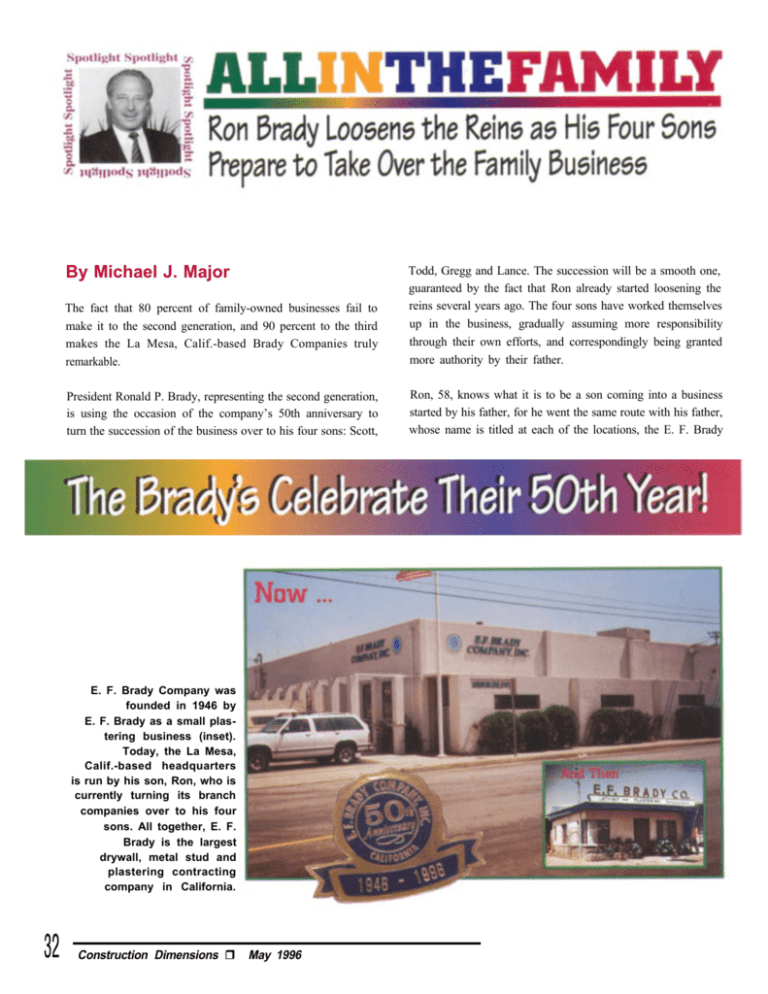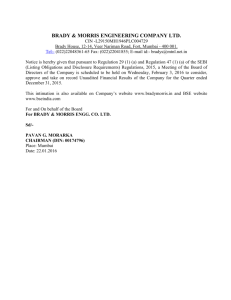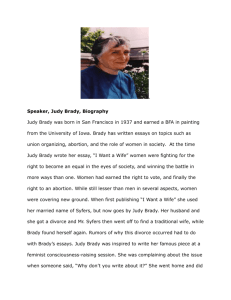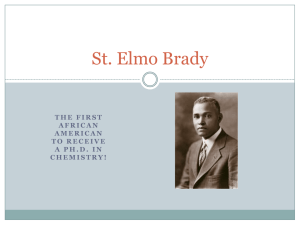All in the Family
advertisement

By Michael J. Major The fact that 80 percent of family-owned businesses fail to make it to the second generation, and 90 percent to the third makes the La Mesa, Calif.-based Brady Companies truly remarkable. Todd, Gregg and Lance. The succession will be a smooth one, guaranteed by the fact that Ron already started loosening the reins several years ago. The four sons have worked themselves up in the business, gradually assuming more responsibility through their own efforts, and correspondingly being granted more authority by their father. President Ronald P. Brady, representing the second generation, is using the occasion of the company’s 50th anniversary to turn the succession of the business over to his four sons: Scott, Ron, 58, knows what it is to be a son coming into a business started by his father, for he went the same route with his father, whose name is titled at each of the locations, the E. F. Brady E. F. Brady Company was founded in 1946 by E. F. Brady as a small plastering business (inset). Today, the La Mesa, Calif.-based headquarters is run by his son, Ron, who is currently turning its branch companies over to his four sons. All together, E. F. Brady is the largest drywall, metal stud and plastering contracting company in California. 32 Construction Dimensions r May 1996 Company, Inc., at San Diego, Los Angeles, Sacramento and Castroville. “My father was a plasterer from Arkansas, who moved all over the Western states trying to make a living,” Ron recalls. “One of the places we lived was in San Diego. Dad’s dream was to move back here and start his own business. That’s what he Ron Brady did, just after the war, in 1946, founding a small plastering business.” Ron got into the business in 1955 with his twin brother, Robert. In the 1960s and 1970s, the company moved into drywall, then metal framing and fireproofing. E. F. passed away in 1978, Robert left the business in 1979 and Ron stayed. Eloise Brady, who helped E. F. start the business, is today a proud mother, grandmother and great-grandmother. young people have to desire to get into the business, and not only from the management side. They have to be willing to work their way up from the bottom, both for their own experience and to earn the respect of those working with them. On the other hand, the elder owner has to be willing to accept the fact that as the new regime takes over, there will, in fact, be casual ties. “These are ideas and processes that contributed to the business for a length of time but do not fit today’s market. New changes are necessary for the business to survive and prosper,” Ron says. Change With the Times There is little doubt that the economic climate has changed significantly, Ron says, especially during the past six years. Previously the business had been about 85 percent private and 15 percent public construction. Now it’s about 80 percent public and 20 percent private. The reason, simply, is that of the main sources of financing for private building, savings and loans, pensions and insurance companies, the latter two have become much more selective, and savings and loans have basically left the picture. Learn by Doing “It’s been extremely interesting to me, having been on the younger end, coming into the business with my father, seeing how things were experienced the hard-nose way, either doing it and surviving or being out, and then having a larger and more sophisticated business today and trying to develop a lot of support systems,” Ron says. “Today it’s both easier and harder.” This change in market has brought about a significant decrease in the building industry. Moreover, the company’s revenues have decreased 35 percent, from an annual revenue of $80 mil- “W ith the changes in attitude that both my sons and their support teams have brought into the business, we have been able to remain profitable. My sons are excited about In the transition of the family business from one generation to the next, Ron says opportunities and challenges, and they have built strong there are two constants. The first, he says is teams with which to grow the company.” “the younger person coming into the business absolutely has to want it. It can’t be —Ron Brady something given to him or put upon him. The second is that those people in the lion to $50 million. Yet, as Ron says, “With the changes in attiolder generation will never think the new generation is ready tude that both my sons and their support teams have brought until they are ready to step aside. So that transition process is into the business, we have been able to remain profitable. My a very tenuous one and has to be worked upon every day, on sons are excited about opportunities and challenges. and they a continual basis.” have built strong teams with which to grow the company.” As an amplification of these two points, Ron explains that continued on page 35 Official Publication of AWCI 33 Brady, continued from page 33 he value of relationships made through AWCI are no doubt part Ron utilizes a number of other people to help form of the Iegacy the Brady family is currently passing on from one teams to support his sons. He mentions E. F. Brady, generation to the next. Inc. President Allen Larson, a high-school friend who started the Central California office in 1964 and who has managed it since. Larson is considered an example and has “assisted greatly in tutoring and coaching the next generation of leaders.” T Other key people include Keith Eshelman, chief financial officer, who often serves as a kind of “clearinghouse” of communication between father and sons; Dave Dolnick, risk manager; and Brad Hixon, manager of business development, who runs the residential housing development subsidiary. Hixon also handles other investments to diversity the Bradys’ construction activities. It’s fitting to mention that Ron, as a past president of The Association of the Wall and Ceiling Industries—International, and one who has served over the years on the AWCI board and executive committee, has nothing but good things to say about the association. “AWCI provides a great resource for anyone willing to participate,” Ron says. The value of relationships developed through AWCI are part of the legacy the Brady family is passing on from one generation to the next. Third Generation Accepts Challenge To turn from father to sons to grandsons—Scott, 35, the oldest, is married Official Publication of AWCI 35 with three children. He started working fill time for the company in 1977 when he was 17 years old. In 1983 he Scott Brady took a hiatus to go to college, graduating from the University of Colorado at Boulder in 1988. He came back to work his way up through a number of management positions and now runs the San Diego office. we like it. We like to build buildings, see them built, then be proud of what we’ve built.” One of the key reasons this family business works where so many have not, Scott says, is “Dad taught us that being a family member was good for two things: advantage in selection for opportunity and communication with the most influential person in the company. Everything else depended on our commitment, effort and results.” Scott credits his father with having the foresight to let the sons take risks and fail, and to learn from those failures. On the other hand, the elder Brady has provided a support team to help prevent those failures from being too serious. “Most family companies fail because of infighting or diverging interests. But we have a common goal to see the company through to the fourth generation. We do it to make money and because Running the Brady office in Los Angeles is Todd, 33, who is also married with three children. He started working full time for the company when he was in high school. He attended California State University at Northridge. “I think what makes this enterprise work is a family commitment,” he says. Todd Brady “We’re all committed to making it happen. We have monthly meetings to pull it all together so no one is left hanging or goes unsupported without help.” Todd says that “Dad has been pretty good at letting the reins go. We update him as we go along and he leaves us free to make decisions.” A common reason for failure in family businesses, Todd says, “is that the younger generation isn’t committed 36 Construction Dimensions r May 1996 enough and doesn’t have the passion for it. The outgoing generations see that, so they stay too involved and don’t let the younger ones make the decisions. It’s not good to have all of the responsi- “D ad never trie d to pressure any of us into joining bility and none of the authority, or just the opposite. You have to have both.” The third son, Gregg, 30, graduated from Arizona State in 1989, is married, and runs the Sacramento office. “When I told dad I wanted to move to Sacramento and he asked if I was serious about the company, I said, ‘You bet I want to do my part.“’ When Gregg was in high school, he started working for his dad. After college, he worked in the field for five years. the business. “It’s an unsaid requirement that you start at the bottom and work your way up,” Gregg says. “But that’s just the way We each came to it our own way.” —Gregg Brady can’t manage it. We were raised to respect what we had and where it came it is. The fact is that if you don’t know how the company operates, you really Gregg Brady from. And dad never tried to pressure any of us into joining the business. We each came to it our own way.” Lance, 27, who is a project manager for the residential housing development offshoot of the company, graduated from Colorado State in 1994 and is Lance Brady married with two children. “We all get along well,” he says. “There’s always been enough room, enough expansion for each of us to take a little piece and make it grow. Dad has been good at coaching us along. He doesn’t push us in any direction, but just offered us an opportunity if we wanted to take it.” 38 Construction Dimensions r May 1996 Lance best sums up this successful fusion of family and business when he says, “I think a lot of our personal drive has to do with the values we grew up with. We all have a good work ethic, and we all enjoy seeing things get built.” Kimberly Brady, 32, has chosen to work in another of the familys’ businesses. She is the manager of one of the largest men’s clothing store chains in San Diego, which is owned and operated by her uncle, Richard Brady. A constant set of values and a strong work ethic have been a Brady trademark Flexibility and empowerment by all generations have allowed the company to increase its market share through a team effort that has grown and prospered for three generations. The company looks forward to a very successful transition into the new millenium. About the Author Michael J. Major of Port Townsend, Wash., is a free-lance writer for the construction industry. Official Publication of AWCI 39









